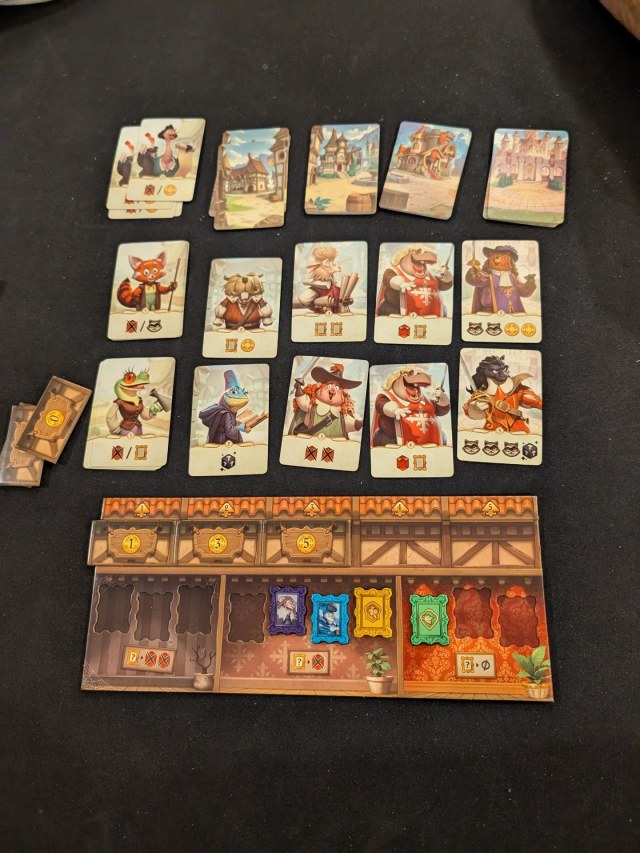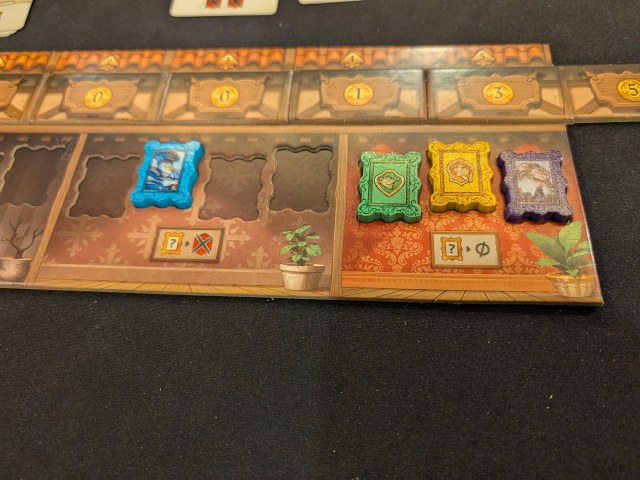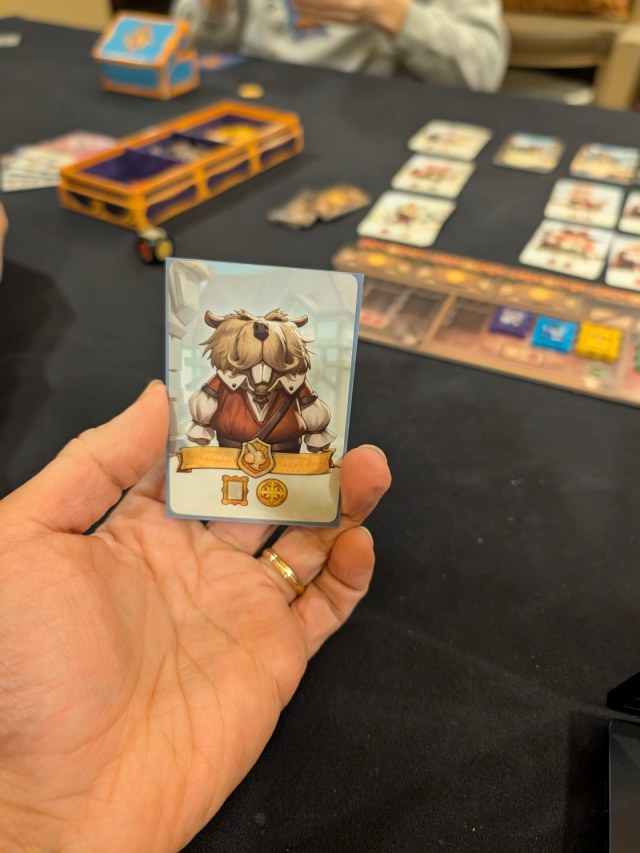For A Crown
- Designer: Maxime Rambourg
- Publisher: Repos
- Players: 3-5
- Age: 8+
- Time: 45 minutes
- Amazon affiliate link:
- Played with review copy provided by publisher
At the dawn of the Renaissance, great empires sought to expand, but amidst these powerhouses were provinces fiercely defending their independence. Their leaders emerged from centuries of rivalry, grudges, alliances, and betrayals. However, in the face of common threats, unity became necessary. A king or queen must be chosen to govern them all.
The court assembles. The noble Houses send forth their most valiant candidates, charged with defending their family’s honor and interests. But to claim the crown, they must prove their worth and offer the kingdom the greatest number of rubies, the region’s most precious symbol of power. These magnificent stones will be set into the crown itself.
Here you stand at court, bearing the hopes and honor of your House. The weight of your family’s treasure rests on your shoulders. You must rally powerful mercenaries and courtiers to your cause. But beware: you’ll also need to strike deals with more questionable characters. Every trick in the book is fair game to weaken your rivals. Your family’s glory depends on it.
For a Crown is more than a race for riches—it’s a game of shaky alliances, cunning betrayals, and merciless bluffing. Who among you has the finesse to claim the precious crown?
Each player chooses a family (color) to play, takes the family chest and fills it with 10 Rubies and their Family Heirloom. They also take their 5 card sleeves. Turn order is randomized and noted on the Gallery area of the board. Each player takes between 3-5 coins based on their initial location in turn order. The Royal Square is constructed, using the five levels of Mercenary cards, each forming a column in their respective area. The Shared Deck is started with the 2 Starting Event cards (these cards are in Neutral card sleeves).
The game is played over 4 rounds, each with 3 phases: Recruit, Reveal, cleanup.
In the Recruit phase, players will use their coins (or rubies as substitutes) to buy a card from the Royal Square display – either a face up card or the top facedown card from a deck. The cost of the card is seen on the price marker in the track underneath each card. The purchased card is placed in a card sleeve of that player’s color and then added to the shared deck. The order of choosing is from most influential to least influential in the Gallery. After all players have bought a card, the Royal Square is refilled. Note that in the first Round, this phase is done twice – but then only done once per round for the last three rounds of the game.
Then in the Reveal phase, the shared deck is shuffled and cards are revealed one at a time, resolving each card in turn until the deck is empty. If an Event card is revealed, all players could be affected. If a Mercenary card is revealed, the owner of the card (signified by the card sleeve it is in) then applies its effect. Examples of possible effects include: gaining rubies or coins, choosing another player to lose a Ruby, altering the player order in the Gallery, rolling the Magic Die, giving another player a Bandit token.
The Magic die comes up a fair amount in the game – it has different icons on its faces which could be good or bad – it’s up to Lady Luck to decide!
At any point in the game, if you must pay a Ruby penalty and you do not have any more Rubies to give, you may sell your Heirloom for 10 Rubies in order to get enough to pay your penalty. If you no longer have your Heirloom, you are eliminated from the game when you cannot pay your penalty.
Once the entire shared deck is resolved, the round ends. In the cleanup phase, a new Event card is added unseen to the Shared deck. Also, a “0 cost” recruitment tile is slid in from the left side of the track, thus altering the price of the mercenaries as well as possibly making more mercenaries available.
After the fourth round (or the end of a round whenever a player is eliminated), the game ends. There is a bit of end-game bonus scoring: The most influential player on the order track gets a ruby and the player with the most coins gets a Ruby. The player with the most Masked Bandit tokens loses a Ruby.
Players tally up their Rubies, counting their Heirloom as 10 Rubies if they still have it. The player with the most Rubies wins. In case of a tie, it is broken in favor of better influence position on the order track.
My thoughts on the game
For A Crown is a deckbuilding game with a twist – because here you are buliding a common deck. Also, every card that you choose will be played each round; so really only the order of effect changes. The concept of choosing a card and putting it into your family’s card sleeve is neat; I don’t remember too many other games going this route in the past.
It’s important to remember what the Events are – as you might end up changing your strategies to try to leverage the events. For instance, if there is an event that rewards turn order, you might try to gain Mercenaries who will help your turn order – as you could then gain the Event reward in each successive round.
Given the way the game plays out, the first round actually feels to be the most important. The two cards you draft in this round will each be resolved four times, so you definitely want to get positive actions for your strategy here. You don’t start with many coins, so you’ll have to decide if it is worth it to splurge on cards (and have to pay Rubies as a result) in the first round – but then gain those stronger actions four times over the rest of the game. All of the actions are very straightforward and there are really only five or six different options available. The difference in the cards is just the number and combination of those simple actions.
The changing prices of the Mercenaries makes for some interesting decisions. The most powerful cards available always cost the most, and players have to decide whether it is worth the cost to buy those cards. As the rounds progress, you will add 0 cost tiles to the left of the track making the lesser cards free to acquire. You can save coins (and rubies) that way, but you’ll have cards that are possibly weaker.
I’ll admit that I don’t understand the whole Heirloom bit. It’s worth 10 Rubies if you need to sell it, and it’s worth 10 Rubies at the end of the game if you still have it. As there is no difference- why not just give players 10 more rubies to start and not need extra rules architecture around it. I mean, I get it if the Heirloom is maybe worth 15 at the end of the game – thus, it’s worthwhile to try to save it during the game. But with the value staying the same, it’s just a 10 Ruby piece that has a lot of rules around it that are un-necessary.
So, for veterans of the blog, you know my feelings on targeted attacks. (NB: I hate them). Here, you have two different actions that allow a player to arbitrarily pick someone out and either make them lose a gem or get a raccoon face. After playing this game, my feelings on targeted attacks haven’t changed. Also, this game has the added unpredictability of doling out some of these targeted attacks based on the result of a die roll. Yay. However, I know there are plenty of gamers who like this sort of thing – heck Munchkin has plenty of targeting in it, and it’s sold literally MILLIONS of copies…
The components are nice, and I do like the storage situation. They provide you with boxes that neatly hold and organize everything. They’ve also been nice enough to give you plenty of extra sleeves should any of yours split.
I really like the idea of the shared deck for deckbuilding, and there is a lot of promise with the use of the individual card sleeves. Unfortunately, for me at least, the resolution of every card in the shared deck feels monotonous, especially in the later rounds where there are just so many cards in the deck, each with the same simple actions on them. When you add in direct targeting of attacks as well as random disruptive dice rolls, this is clearly not the game for me, but then I’ve never been one for the “delightfully French” sort of game. I can see how this would appeal to someone who leans towards the Bruno F end of the gaming spectrum – if you’re one of those, I’ve got a game for you! You can buy it from me For a Crown. Or even Half a Crown. (And, I just learned that is is one of the three finalists for the 2024 French game of the year – so certainly the designer and the publisher know their audience!)
Until your next appointment
The Gaming Doctor







